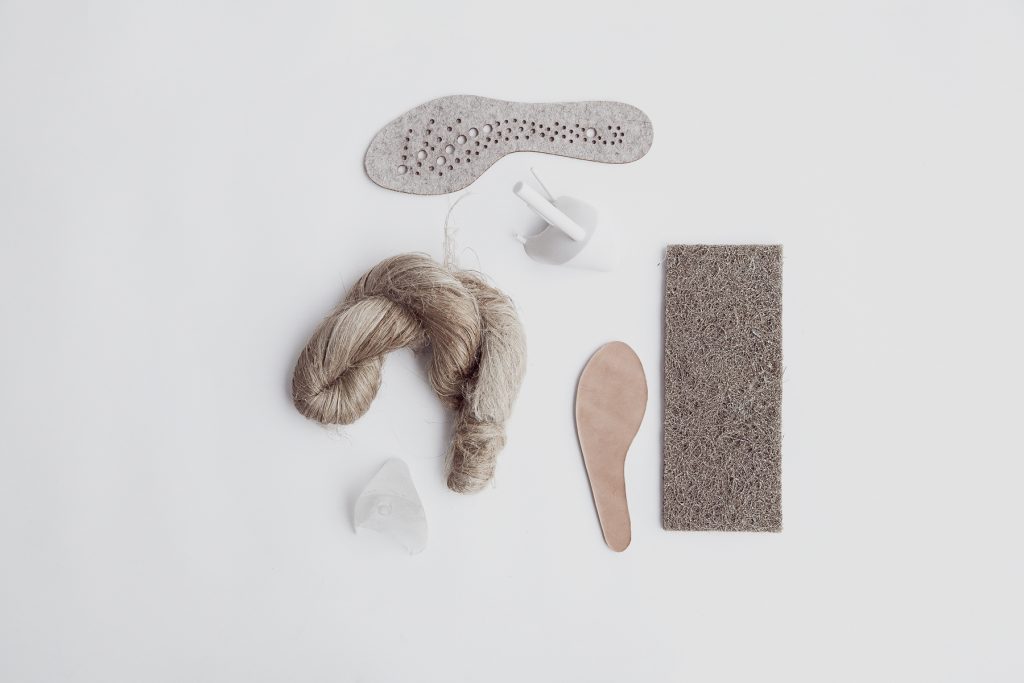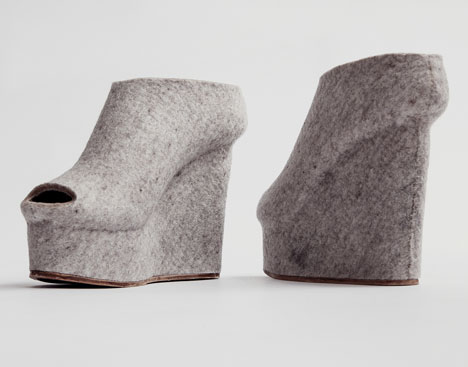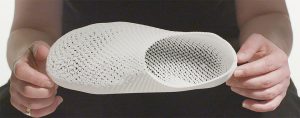Liz Ciokajlo is a footwear designer and researcher, focusing on the impact material innovation and emerging making processes has on design constructions and form. Her aim is to bring a fresh look at how materials and technologies can underpin and reshape fashion footwear at the most emotive levels through her firm OurOwnSkin.
Give us some background on your own experience and how it has lead you to this point.
I studied at the University of Cincinnati and did industrial design. I then moved to the UK and worked as a product and furniture design for years. I then fell into work as a fashion accessory designer out of practicality. In 2011 I started an MA in footwear. I was combining fashion, leatherwear, and then furniture and product design. I was looking through a product lens and I believed 3D Printing would give designers more accessibility to actually creating and manufacturing locally to offer more control and innovation in proposed designs. I was dissatisfied with the materiality that was offered at first. Then I stumbled upon naturally nonwovens and softer materials which had the properties of mass customisation. Then I started learning more about synthetic biology and how we can create more mass customization. I felt I could address limited 3D print materials at this time. At the time I was doing a lot of innovative work with companies working on 3D printing and design.

Can you give us some insight into what you do with OurOwnSkin?
We want to inform and inspire design concepts. Concepts are underpinned by talking to wearers. Rhian Solomon my business partner has vast experience in facilitating workshops to inform ideas. With the OurOwnSkin shoe we collaborated with Manolis Papastavrou to create a structure inspired by human skin. This is a responsive 3D printed structure which behaves similar to skin. Following this research project we worked with King’s College London for a scoping project to design footwear for people living with EB. We believe the low run bespoke quality coupled with the fine, complex and parametric features of 3D print could offer solutions for this small group of wearer’s needs.. It is important to see multidisciplinary teams that can be seen with products and fashion. The innovation we gain from the projects we do can spill into other fields.
What are your thoughts on technology and how it is shaping the future of footwear?
You can track and sensor everything now. Technology should be invisible. Material technology that is responsive is the most interesting. It can correct some many aspects such as posture and stance. Ultimately, my personal interest is in how the technology, especially new and novel materials are defined into footwear aesthetics. Technology will be complemented by cultural factors. In footwear design evolution terms, we have designed the way the foot looks but in the future we will build it for how it feels.
3D printing is very interesting as a subject matter for footwear designers. How practical do you think 3D printing is for footwear design?
3D print is undeniably a key way to manufacture footwear now and in the future, but the uptake has been slow. This is probably due to the investment in the factories and established systems of making over 24 billion pairs of shoes a year! The slow uptake is also probably due to the evolution of the relationship between footwear, making, machine and people. Pre industrial revolution we made shoes by hand. Then we built machines to automate hand making processes. Developed systems of machines and processes lead us to the stage we are in today where arguably the machines are driving the design forms. With the OurOwnsKIN shoe structure we hoped to add a bit of something inspired by our bodies into the 3D printed lattices.
What are some essential skills for future footwear designers?
I think it is understanding the foot and the body. I think it is understanding people’s emotions. I think it is understanding materials. Those are the top items. Process and assembly are very important. Practical skills include parametric design. I think understanding supply chains is important as well. There will be various people with specialized skills. If designers do not focus on the materials they will be limited.
What are some good resources and biomaterials to be focused on when it comes to fashion?
Currently, there is some wonderful work being done in applying circular economy models to polymer-based materials in fashion. I think a big push is needed circular systems with biodegradable materials. To really get our heads around collectively accessing local materials and reducing emissions from far distance distribution models. Many of the leaders in the area biomaterials for fashion have gathered and spoken at the Biofabricate Conferences in New York. I have been fortunate enough to work with mycelium material from MOGU which shows great promise!
What are some of your favorite projects that you have done with various technology media as well as design?
The MarsBoot was one of my favourite projects. I did a lot of research on space expecting the people I spoke with to be very technically focused at the exclusion of humanities. This was not the case at all. Digging into history I discovered the father of the space movement was a philosopher. He imagined that we would overcome death and therefore need to expand to other places. Space is driven by human desires. As designers we are always contributing to ideas that make the world better. We do a lot of work that is speculative but we also work on practical ideas as well.
What are your goals in terms of the fashion industry within the next 5 years?
I’d like to combine footwear with other objects, biological materials, and 3D Printing. I’d love to try and print a skin shoe with biological materials. Myself and my business partner would love to build a body materials library.
Subscribe to Our Email Newsletter
Stay up-to-date on all the latest news from the 3D printing industry and receive information and offers from third party vendors.
You May Also Like
3D Printing Financials: Fathom Struggles in Financial Quicksand During Critical Transition
Facing a year of key transitions and financial pressures, Fathom (Nasdaq: FTHM) has filed its annual report for 2023 with the U.S. Securities and Exchange Commission (SEC). The document outlines...
Latest Earnings Overview for Australian 3D Printing Firms Titomic and AML3D
Australian 3D printing manufacturing firms Titomic (ASX: TTT) and AML3D (ASX: AL3) reported their financial results for the period from July to December 2023, marking the first half of their...
3D Printing Webinar and Event Roundup: April 7, 2024
Webinars and events in the 3D printing industry are picking back up this week! Sea-Air-Space is coming to Maryland, and SAE International is sponsoring a 3D Systems webinar about 3D...
3D Printing Financials: Unpacking Farsoon and BLT’s 2023 Performance
In the Chinese 3D printing industry, two companies, Farsoon (SHA: 688433) and Bright Laser Technologies, or BLT (SHA: 688333), have recently unveiled their full-year earnings for 2023. Farsoon reported increases...



































